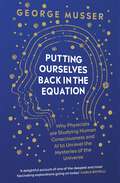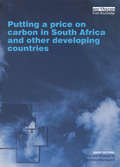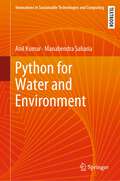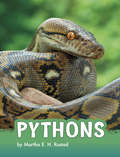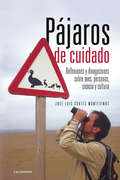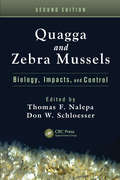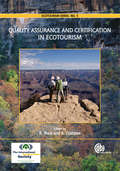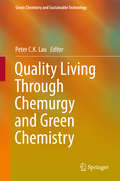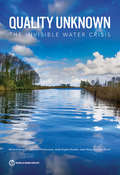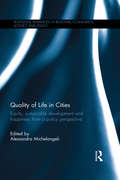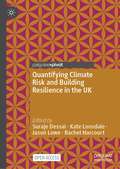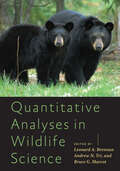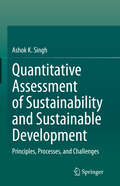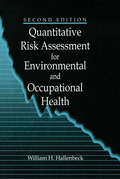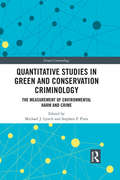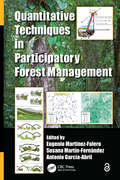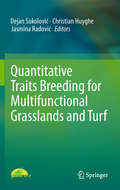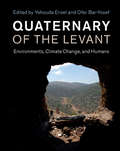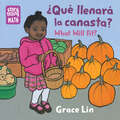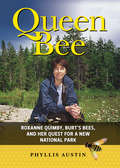- Table View
- List View
Putting Ourselves Back in the Equation: Why Physicists Are Studying Human Consciousness and AI to Unravel the Mysteries of the Universe
by George MusserDistant galaxies, dark matter, black holes – elusive, incomprehensible and inhospitable – these are the building blocks of modern physics. But where do we fit in this picture? For centuries, we have separated mind from matter. While physicists have pursued a theory of &‘everything&’ with single-minded purpose, the matter of the mind, of human consciousness, has been conveniently sidestepped and ignored – consigned to priests, philosophers and poets. With the ambition of Stephen Hawking, Carlo Rovelli and Brian Cox, Putting Ourselves Back in the Equation sets out a bold new vision for theoretical physics, unrestricted by sleek equations and neat formulations. Combining cutting-edge neuroscience with the latest in quantum mechanics, acclaimed writer Musser offers a new interpretation of human consciousness. From bizarre cognitive phenomena, like lucid dreaming and self-taught synaesthesia, to the latest technological developments in AI, Musser asks: what can physics teach us about what it means to be human?
Putting a Price on Carbon in South Africa and Other Developing Countries (Climate Policy Ser.)
by Harald WinklerHow should we be putting a price on carbon, particularly in developing countries? This volume takes up this contested issue and examines how different economic instruments might apply in developing countries, with a special focus on South Africa. The papers included address a variety of themes in this area: Emissions trading, carbon taxes, fiscal and non-fiscal instruments, policy and institutional dimensions, and lessons from the Clean Development Mechanism. Presenting the very latest research, the volume will be of interest to academics and policymakers in economics, policy and development.
Python for Water and Environment (Innovations in Sustainable Technologies and Computing)
by Anil Kumar Manabendra SahariaThis textbook delves into the practical applications of surface and groundwater hydrology, as well as the environment. The Part I, "Practical Python for a Water and Environment Professional," guides readers through setting up a scientific computing environment and conducting exploratory data analysis and visualization using reproducible workflows. The Part II, "Statistical Modeling in Hydrology," covers regression models, time series analysis, and common hypothesis testing. The Part III, "Surface and Subsurface Water," illustrates the use of Python in understanding key concepts related to seepage, groundwater, and surface water flows. Lastly, the Part IV, "Environmental Applications," demonstrates the application of Python in the study of various contaminant transport phenomena.
Pythons (Animals)
by Martha E. RustadPythons are some of the largest snakes in the world. They squeeze their prey with their bodies, and have flexible jaws so they can swallow big animals. Get all the facts on these powerful snakes.
Pájaros de cuidado: Reflexiones y divagaciones sobre aves, personas, ciencia y cultura
by José Luis Cortés Montesinos¿Abejarucos y Fórmula 1? ¿Buitres o pardillos? ¿Ciencia o leyenda? Pájaros y algo más. ¿Alguna vez te han llamado cabeza de chorlito o pardillo, águila, cernícalo, buitre o chotacabras? ¿Tienes la cabeza a pájaros o eres un pájaro de cuidado? Todos los pájaros lo son, de cuidado. Debemos cuidarlos, porque, además de impregnar nuestra cultura, su comportamiento, sus plumajes y sus cantos son un espectáculo gratificante. Cada capítulo de este libro da fe de ello, pues Pájaros de cuidado es una serie de vivencias y reflexiones en torno a las aves, los lugares que habitan y algunas personas vinculadas a ellas. Reflexiones basadas en la biología evolutiva y la ecología, en leyendas y en el origen de sus nombres, con un tono desenfadado y a veces irónico, pero siempre inspirado por el disfrute del contacto con la naturaleza y la importancia de la ciencia para su comprensión.
Quagga and Zebra Mussels: Biology, Impacts, and Control, Second Edition
by Thomas F. Nalepa Don W. SchloesserThe introduction and rapid spread of two Eurasian mussel species, Dreissena polymorpha (zebra mussel) and Dreissena rostriformis bugensis (quagga mussel), in waters of North America has caused great concern among industrial and recreational water users. These invasive species can create substantial problems for raw water users such as water treatme
Quality Assurance and Certification in Ecotourism
by Rosemary Black Alice CrabtreeThis book explores solutions to the problems of inconsistency and even exploitation of the term ecotourism through examples, case studies and a discussion of quality control and certification.
Quality Living Through Chemurgy and Green Chemistry
by Peter C.K. LauThis book is intended to give readers an appreciation of what the future holds, as cutting-edge technologies in synthetic biology and pathway engineering and advanced bioprocessing development pave the way for providing goods and services to benefit humankind that are based on the synergy of two biomasses - i. e. of what a renewable feedstock could yield and an infinite microbial biomass could provide in terms of enzymes and biocatalysts. This 13-chapter book, with an introductory treatise on the guiding principles of green chemistry and engineering metrics, brings together a broad range of research and innovation agendas and perspectives from industries, academia and government laboratories using renewable feedstocks that include macroalgae and lignins. In addition, social-economic aspects and the pillars of competitiveness in regional cluster development are explored as we transition from fossil-fuel-based economies to a circular bioeconomy, with chemurgy and green chemistry being implicit to the innovation movement. The bulk of the book covers specific applications including the bioproduction of amino sugars, dicarboxylic acids, omega-3 fatty acids, starch and fermentable sugars from lignocellulosic materials, and phenolics as building blocks for polymer synthesis. Enzymatic systems for accessing chiral and special-purpose chemicals, as well as the development of specialized enzymes from macroalgae for biofuel and biochemical production are also addressed. Research gaps, hurdles to overcome in various biological processes, and present achievements in the production of biofuels and biochemicals from lignocellulosic materials are discussed. Going beyond the conventional expectation of discussing the production of drop-in chemicals, the book instead emphasizes how the potential of new chemicals and materials can be harnessed through innovative thinking and research. As such, it provides an invaluable reference source for researchers and graduate students interested in Chemurgy and Green Chemistry, as well as for practitioners in the field of industrial biotechnology and biobased industry. Peter C. K. Lau is a Distinguished Professor at Tianjin Institute of Industrial Biotechnology of the Chinese Academy of Sciences, and an Adjunct Professor at the Departments of Chemistry and Microbiology & Immunology, McGill University, Canada.
Quality Unknown: The Invisible Water Crisis
by Richard Damania Sébastien Desbureaux Aude-Sophie Rodella RussWater quantity—too much in the case of floods, or too little in the case of droughts—grabs public attention and the media spotlight. Water quality—being predominantly invisible and hard to detect—goes largely unnoticed. Quality Unknown: The Invisible Water Crisis presents new evidence and new data that call urgent attention to the hidden dangers lying beneath water’s surface. It shows how poor water quality stalls economic progress, stymies human potential, and reduces food production. Quality Unknown examines the effects of water quality on economic growth and finds upstream pollution lowers growth in downstream regions. It reveals that some of the most ubiquitous contaminants in water, such as nitrates and salt, have impacts that are larger, deeper, and wider than has been acknowledged. And it traces the damage to crop yields and the stark implications for food security in affected regions. An important step toward tackling the world’s water quality challenge is recognizing its scale. The world needs reliable, accurate, and comprehensive information so that policy makers can have new insights, decision making can be evidence based, and citizens can call for action. The report calls for a paradigm shift that emphasizes safer, and often more cost-effective remedies that prevent pollution by combining smarter policies with newer technologies. A key message of Quality Unknown is that such solutions exist and change is possible.
Quality and Legitimacy of Global Governance
by Timothy CadmanSince the Rio 'Earth' Summit of 1992, sustainable development has become the major policy framework through which the international community deals with pressing environmental issues such as deforestation. Implicit in this approach is the belief that the market provides the best mechanism to bring government, business and society together, and a whole plethora of market-driven schemes have been developed in response. Yet how legitimate are these institutions, and where is their democratic accountability? This book looks at four institutions created to address forest management, namely the Forest Stewardship Council (non-governmental), the Programme for the Endorsement of Forest Certification (business), the ISO 14000 Series of environmental standards (technocratic), and the United Nations Forum on Forests (governmental). It finds large discrepancies in the approaches taken, and the degree to which the four systems provide for meaningful participation and productive deliberation amongst stakeholders trying to address the global forest crisis.
Quality of Life in Cities: Equity, Sustainable Development and Happiness from a Policy Perspective (Routledge Advances in Regional Economics, Science and Policy)
by Alessandra MichelangeliIn the last few decades, urban quality of life has received increasing interest from policy makers who aim to make cities better places to live. In addition to the aim of improving quality of life, sustainable and equitable development is also often included in the policy agendas of decision makers. This book aims to link quality of life to related issues such as sustainability, equity, and subjective well-being. While less than one-third of the world's population lived in cities in 1950, about two thirds of humanity is expected to live in urban areas by 2030. This dramatic increase in the number of people living in urban areas serves as the backdrop for this book’s analysis of cities. This book will be useful to students and researchers in economics, architecture and urban planning, sociology and political sciences, as well as policy makers.
Quantified
by Joe WhitworthGoogle, Apple, Amazon, Uber: companies like these have come to embody innovation, efficiency, and success. How often is the environmental movement characterized in the same terms? Sadly, conservation is frequently seen as a losing battle, waged by well-meaning, but ultimately ineffective idealists. Joe Whitworth argues it doesn't have to be this way. In fact, it can't be this way if we are to maintain our economy, let alone our health or the planet's. In Quantified, Whitworth draws lessons from the world's most tech-savvy, high-impact organizations to show how we can make real gains for the environment. The principles of his approach, dubbed quantified conservation, will be familiar to any thriving entrepreneur: situational awareness, bold outcomes, innovation and technology, data and analytics, and gain-focused investment. This no-nonsense strategy builds on the inspirational environmental work begun in the 1970s, while recognizing that the next economy will demand new solutions. As President of The Freshwater Trust, Whitworth has put quantified conservation into practice, pioneering the model of a "do-tank" that is dramatically changing how rivers can get restored across the United States. The stories in Quantified highlight the most precious of resources--water--but they apply to any environmental effort. Whether in the realm of policy, agriculture, business, or philanthropy, Whitworth is charting a new course for conservation.
Quantified: Redefining Conservation for the Next Economy
by Joe S. WhitworthGoogle, Apple, Amazon, Uber: companies like these have come to embody innovation, efficiency, and success. How often is the environmental movement characterized in the same terms? Sadly, conservation is frequently seen as a losing battle, waged by well-meaning, but ultimately ineffective idealists. Joe Whitworth argues it doesn't have to be this way. In fact, it can't be this way if we are to maintain our economy, let alone our health or the planet's. In Quantified, Whitworth draws lessons from the world's most tech-savvy, high-impact organizations to show how we can make real gains for the environment. The principles of his approach, dubbed quantified conservation, will be familiar to any thriving entrepreneur: situational awareness, bold outcomes, innovation and technology, data and analytics, and gain-focused investment. This no-nonsense strategy builds on the inspirational environmental work begun in the 1970s, while recognizing that the next economy will demand new solutions. As President of The Freshwater Trust, Whitworth has put quantified conservation into practice, pioneering the model of a "do-tank" that is dramatically changing how rivers can get restored across the United States. The stories in Quantified highlight the most precious of resources--water--but they apply to any environmental effort. Whether in the realm of policy, agriculture, business, or philanthropy, Whitworth is charting a new course for conservation.
Quantifying Climate Risk and Building Resilience in the UK
by Jason Lowe Suraje Dessai Kate Lonsdale Rachel HarcourtThis open access book draws together key research from the UK Climate Resilience programme. It focuses on topics central to the programme’s research agenda, including improved characterisation and quantification of climate risks, enhanced understanding of the management of climate risks, and the development and delivery of climate services. Key chapters address the challenges inherent to undertaking resilience research, including how to make the term ‘climate resilience’ usable and useful, co-producing research between academics, policy makers and practitioners, and engaging and communicating outside of academia. This book is unique in providing a concise and accessible overview of the programme’s key lessons, placing the findings into a wider context and it will inform future research, policy and practice agendas.
Quantitative Analyses in Wildlife Science (Wildlife Management and Conservation)
by Leonard A. Brennan, et al.An authoritative guide to quantitative methods that will help wildlife scientists improve analysis and decision-making.Over the past fifty years, wildlife science has become increasingly quantitative. But to wildlife scientists, many of whom have not been formally trained as biometricians, computer modelers, or mathematicians, the wide array of available techniques for analyzing wildlife populations and habitats can be overwhelming. This practical book aims to help students and professionals alike understand how to use quantitative methods to inform their work in the field. Covering the most widely used contemporary approaches to the analysis of wildlife populations and habitats, Quantitative Analyses in Wildlife Science is divided into five broad areas:• general statistical methods• demographic estimation• dynamic process modeling• analysis of spatially based data on animals and resources• numerical methodsAddressing a variety of topics, from population estimation and growth trend predictions to the study of migration patterns, this book presents fresh data on such pressing issues as sustainable take, control of invasives, and species reintroduction. Authored by leading researchers in wildlife science, each chapter considers the structure of data in relation to a particular analytical technique, as well as the structure of variation in those data. Providing conceptual and quantitative overviews of modern analytical methods, the techniques covered in this book also apply to conservation research and wildlife policy. Whether a quick refresher or a comprehensive introduction is called for, Quantitative Analyses in Wildlife Science is an indispensable addition to every wildlife professional's bookshelf. Contributors: William M. Block, Leonard A. Brennan, Stephen T. Buckland, Christopher C. Chizinski, Evan C. Cooch, Raymond J. Davis, Stephen J. DeMaso, Randy W. DeYoung, Jane Elith, Joseph J. Fontane, Julie A. Heinrichs, Mevin B. Hooten, Julianna M. A. Jenkins, Zachary S. Laden, Damon B. Lesmeister, Daniel Linden, Jeffrey J. Lusk, Bruce G. Marcot, David L. Miller, Michael L. Morrison, Eric Rexstad, Jamie S. Sanderlin, Joseph P. Sands, Erica F. Stuber, Chris Sutherland, Andrew N. Tri, David B. Wester, Gary C. White, Christopher K. Williams, Damon L. Williford
Quantitative Assessment of Sustainability and Sustainable Development: Principles, Processes, and Challenges
by Ashok K. SinghThis volume discusses and analyses the use of quantitative indicators to assess sustainability across sectors, with the goal of offering readers the tools to choose and validate indicators. Sustainability (SU) and sustainable development (SD) are critical for survival of humanity, but fraught with both definitional and measurement issues. SU and SD are complex multidimensional processes exhibiting (i) social, cultural, and economic variabilities, (ii) a lack of unified definition, and (iii) conceptual vagueness. These deficiencies complicate attempts to measure the effectiveness of SU/SD efforts and make comparisons across programs and geographies difficult. This book explains, in clear terms, the causes, consequences, and assessment of SU and SD deficiencies. An indicator developed for one geographical or climate region may or may not accurately assess sustainability status of another system in different region. That is why, in spite of plenty indicators currently available, there is a need to validate existing or new indicators to assess sustainability. This book develops a database of indicators targeting different aspects of SU and SD and discusses the indicators’ elasticity, range, advantages and disadvantages. The book also provides theoretical and applied information regarding selection of indicators online and/or design new indicators. This volume is targeted toward faculty and graduate/postgraduate scholars working in research areas relevant to sustainability, especially those looking for assessment methodologies and advice on selection and validation of relevant indicators.
Quantitative Risk Assessment for Environmental and Occupational Health
by William H. HallenbeckQuantitative Risk Assessment for Environmental and Occupational Health, Second Edition features twice as many risk analysis models with complete examples as the previous edition. The book features new information in the following areas:Calculation of human dose rate and dose from experimental studies (animal and human) Quantitat
Quantitative Studies in Green and Conservation Criminology: The Measurement of Environmental Harm and Crime (Green Criminology)
by Michael J. Lynch Stephen F. PiresDuring the early development and throughout the short history of green/conservation criminology, limited attention has been directed toward quantitative analyses of relevant environmental crime, law and justice concerns. While recognizing the importance of establishing a theory and terminology in the early stages of development, this book redresses this imbalance. The work features contributions that undertake empirical quantitative studies of green/conservation crime and justice issues by both conservation and green criminologists. The collection highlights the shared concerns of these groups within important forms of ecological crime and victimization, and illustrates the ways in which these approaches can be undertaken quantitatively. It includes quantitative conservation/green criminological studies that represent the work of both well-established scholars in these fields, along with studies by scholars whose works are less well-known and who are also contributing to shaping this area of research. The book presents a valuable contribution to the areas of Green and Conservation Criminology. It will appeal to academics and students working in these areas.
Quantitative Techniques in Participatory Forest Management
by Eugenio Martínez-FaleroForest management has evolved from a mercantilist view to a multi-functional one that integrates economic, social, and ecological aspects. However, the issue of sustainability is not yet resolved. Quantitative Techniques in Participatory Forest Management brings together global research in three areas of application: inventory of the forest variables that determine the main environmental indices, description and design of new environmental indices, and the application of sustainability indices for regional implementations. All these quantitative techniques create the basis for the development of scientific methodologies of participatory sustainable forest management.
Quantitative Traits Breeding for Multifunctional Grasslands and Turf
by Dejan Sokolović Christian Huyghe Jasmina RadovićGrasslands are among the largest ecosystems in the world and consequently are of great importance to mankind. The genotypes of the species which are the main components of the grasslands have great influence on total outcome and successful utilization of grasslands. Therefore fodder crops and turf swards should be constantly improved to follow modern trends in agriculture production and landscape architecture. The wide range of breeding programs for forage and amenity species, as well as new breeding methods and techniques, is rapidly expanding the boundaries and is making it possible to achieve outstanding breeding results. This book includes papers presented at the 30th EUCARPIA Fodder Crops and Amenity Grasses Section Meeting. The challenging title of the book focuses on breeding of quantitative traits, which directly impact the profitability and sustainability of grasslands and fodder crops production, as well as on multidisciplinary approach in grassland research and utilisation. Included papers offer a unique collection of ideas and breakthroughs in the fields of fodder crops and amenity grasses breeding and genetics, as well as in the creative and innovative application of new tools in practical breeding.
Quaternary Environmental Change in Southern Africa
by Knight, Jasper and Grab, Stefan W. Jasper Knight Stefan W. GrabOngoing climate change necessitates advances in our understanding of the interrelationships between climate, landscape-shaping processes and human activity over long time periods, especially in areas that are already climatically stressed. This volume presents new ideas on macroscale landscape evolution; mountain, fluvial and aeolian processes; and environments in southern Africa, a key region in the story of human evolution during the last two million years. Interdisciplinary in scope, it brings together an international team of experts to synthesise the latest research and understanding of landscape-human relationships in this region. It incorporates results from the emerging fields of geoarchaeology and cultural landscapes and utilises the latest data and analytical techniques. A key reference for researchers studying hominid evolution, geoarchaeology and environmental change, it provides a benchmark study of southern African landscape evolution during the Quaternary. It will also appeal to professionals and policymakers with interests in future human-landscape evolution in southern Africa.
Quaternary Sea-Level Changes
by Colin V. Murray-Wallace Colin D. WoodroffeThere have been significant changes in sea level over the past two million years, and a complete understanding of natural cycles of change as well as anthropogenic effects is imperative for future global development. This book reviews the history of research into these sea-level changes and summarises the methods and analytical approaches used to interpret evidence for sea-level changes. It provides an overview of changing climates during the Quaternary, examines processes responsible for global variability of sea-level records, and presents detailed reviews of sea-level changes for the Pleistocene and Holocene. The book concludes by discussing current trends in sea levels and likely future sea-level changes. This is an important and authoritative resource for academic researchers and graduate and advanced undergraduate students working in tectonics, stratigraphy, geomorphology, physical geography, environmental science and other aspects of Quaternary studies.
Quaternary of the Levant: Environments, Climate Change, and Humans
by Yehouda Enzel Bar-Yosef OferQuaternary of the Levant presents up-to-date research achievements from a region that displays unique interactions between the climate, the environment and human evolution. Focusing on southeast Turkey, Lebanon, Syria, Jordan and Israel, it brings together over eighty contributions from leading researchers to review 2. 5 million years of environmental change and human cultural evolution. Information from prehistoric sites and palaeoanthropological studies contributing to our understanding of 'out of Africa' migrations, Neanderthals, cultures of modern humans, and the origins of agriculture are assessed within the context of glacial-interglacial cycles, marine isotope cycles, plate tectonics, geochronology, geomorphology, palaeoecology and genetics. Complemented by overview summaries that draw together the findings of each chapter, the resulting coverage is wide-ranging and cohesive. The cross-disciplinary nature of the volume makes it an invaluable resource for academics and advanced students of Quaternary science and human prehistory, as well as being an important reference for archaeologists working in the region.
Que Llenara Canasta? / What Will Fit? (Storytelling Math)
by Grace LinNow in Spanish bilingual editions--Caldecott Honor winner Grace Lin celebrates math for every kid in this board book series.Take a trip to the farmers market in this playful story about spatial sense. Olivia is searching for something just the right size to fill her basket. The apple is so small that it rolls around. The zucchini is so long that it sticks out. What will fit just right? The Storytelling Math series shows that all children can be mathematical thinkers. Each book includes ideas for exploring math at home with your children, developed in collaboration with math experts at STEM education nonprofit TERC Inc., under a grant from the Heising-Simons Foundation.
Queen Bee: Roxanne Quimby, Burt's Bees, and Her Quest for a New National Park
by Phyllis AustinHow did she navigate the world of venture capitalists and investment bankers to engineer the sale of her company and reap a personal fortune? And what does her subsequent odyssey to buy and donate a new national park in Maine's north woods--thus repaying what she regards as the "harmonic debt to the planet" she incurred by manufacturing beauty products--tell us about America and the American dream? Queen Bee is a fascinating biography of a fascinating woman, her game-changing skin-care company, and the quest to create a national park in the north woods. A richly textured portrait of the woman who built Burt's Bees from nothing and altered the global business of skin care. A tightly woven story of the paper-industry exodus, the giant clearance sale of the north woods, the downward spiral of paper-company towns, and the battle for a new national park. A tale of the American Dream in action-- what it can do for the fortunate few who are in the right place at the right time with wits and determination, and what it can do to the unfortunate many who find themselves on the wrong side of "creative destruction."
